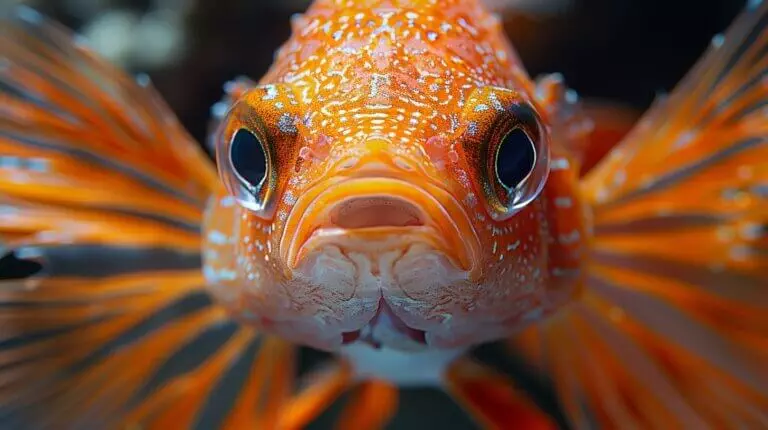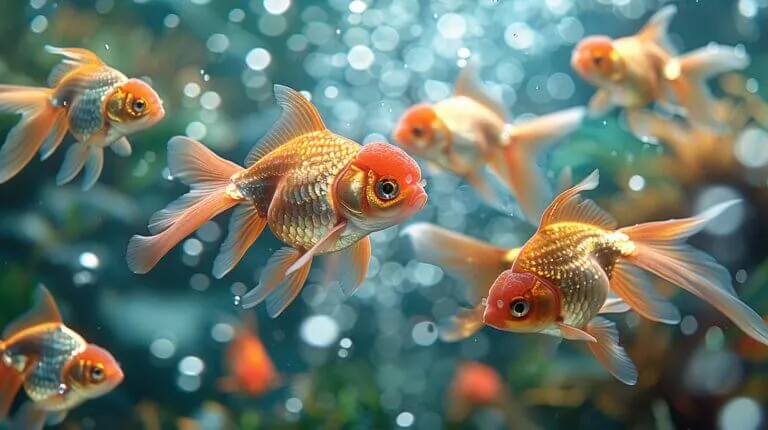Hard water can harm your aquarium fish. Heavy minerals stress them out and mess with their health. 2 So, how do you make soft water for your tank? This guide shows you safe ways to soften aquarium water without hurting your fish.
As an experienced aquarist, I’ve dealt with hard water issues for years. I’ll share proven methods to test and adjust the hardness of the water. 1 You’ll understand how to soften aquarium water. Plus, you’ll learn natural and chemical softening techniques that work.
Let’s explore how to create the perfect soft water home for your fish. 3
Key Takeaways
- Test your aquarium water often with kits to check hardness (high GH and KH) and high ph levels.
- Use natural methods like driftwood, peat moss, or by adding Indian almond leaves to soften water gently.
- Try chemical additives or water softening pillows to bring down the hardness of the water quickly, but follow instructions carefully.
- Do partial water changes (25% to 50%) weekly to remove waste and add fresh water.
- For very soft water, use reverse osmosis systems that remove up to 99% of dissolved solids.
Understanding Water Hardness and Its Effects on Aquatic Environments

Water hardness affects your fish and plants. Hard water has lots of minerals that can harm some aquatic life.
Basics of Water Chemistry: GH, KH, and Their Roles in Aquariums
GH and KH play key roles in aquarium health. GH measures the levels of calcium and magnesium ions, while KH shows the water’s ability to keep pH stable. For freshwater tanks, aim for 4 to 8 dGH and 4 to 8 dKH. These levels help fish thrive and keep your tank balanced. 1
pH is also crucial, with most fish doing best between 6.5 and 8.0. Test your water often to catch changes early. Use a good test kit to check GH, KH, and pH. This helps you keep your fish happy and healthy.
A balanced aquarium is a happy aquarium.
The Consequences of Hard Water for Aquatic Plants and Fish
Hard water affects your aquarium’s delicate balance. It can harm your fish and sensitive plants in several ways. High mineral content makes it tough for plants to absorb nutrients. This leads to slow growth and yellowing leaves.
Fish may struggle to breathe and reproduce in hard water. Their gills can get clogged with mineral deposits. 2
Algae thrives in hard water, competing with your plants for resources. This creates an unsightly tank and stresses your fish. Some species adapt to hard water, but others can’t breed in it.
Soft water fish may show signs of stress like rapid breathing or loss of color. Regular water tests help you spot these issues early and take action to protect your aquatic friends. 3
Identifying Sources of Hard Water in Home Aquariums
Your tap water is often the main source of hard water in home aquariums. Minerals like calcium and magnesium dissolve in water as it flows through rocks and soil. These dissolved minerals make the water “hard.” Well water can be extra hard, especially in areas with lots of limestone.
You can test your tap water’s hardness with a simple kit from a pet store. If you find your water is hard, don’t worry! There are ways to soften it for your fish friends. 4
Methods to Test and Assess Water Hardness in Aquarium

You need to know your tank’s water hardness. Test kits help you check this fast and easy.
https://www.youtube.com/watch?v=aqFtGqvtYwk
Utilizing Water Test Kits for Accurate Water Hardness Readings
Water test kits are key for fish tank health. They measure General Hardness (GH) and Carbonate Hardness (KH). GH shows mineral content, while KH indicates water stability. Use these kits weekly to check your tank’s levels.
Aim for GH below 3 for soft water and KH around 6. This balance keeps fish happy and plants thriving. Regular testing helps spot issues early, saving time and fish lives. 5
Interpreting Water Test Results and Determining Necessary Adjustments
After using test kits, you’ll need to interpret the results. Test results show GH (general hardness) and KH (carbonate hardness) levels. GH measures calcium and magnesium in the water, while KH indicates buffering capacity.
Very hard water has GH above 28°dH and KH over 20°dH. This promotes algae growth and stresses some fish. To soften water, use RO/DI systems, aquarium soil, or driftwood. For harder water, add SL-Aqua conditioners, limestone rocks, or crushed coral.
Check levels often to maintain ideal water conditions for your aquatic pets. Adjust slowly to avoid shocking fish. 6
The Role of Professional Services and Products in Water Hardness Testing
Professional services offer expert water testing for your aquarium. They use advanced tools to check levels of water hardness with precision. You can get detailed reports on minerals in the water.
These pros help you pick the right methods to remineralize and manage water hardness. 7
Products like the API GH/KH kit let you test water at home. They’re easy to use and give quick results. With these kits, you can keep track of your tank’s hardness over time.
Techniques for Softening Hard Aquarium Water

You can soften hard aquarium water using natural agents, chemicals, or water changes. Want to learn more about these methods? Keep reading! One natural agent you can use to soften hard aquarium water is peat moss, which can be added to the filter or directly into the water. Chemicals such as water conditioners specifically designed to soften water can also be used, following the instructions on the product label. Additionally, regular water changes with soft, clean water can be a simple and effective way of maintaining optimal water quality. However, it’s important to monitor the water parameters regularly to ensure the water remains at the proper hardness and pH levels for the fish and other aquatic life in the aquarium.
Natural Softening Agents and Their Effects on Water Parameters
Natural softening agents offer a gentle way to adjust aquarium water. Driftwood and Catappa leaves release tannins, which lower the pH and soften water. These botanicals mimic natural habitats, creating ideal conditions for many fish species. They also turn the water tea-colored, enhancing the tank’s look. 8
Peat moss acts as another effective softener. It slowly releases organic compounds that reduce hardness and acidity. But be careful – quick changes can stress fish. Start with small amounts and test often.
Your fish will thank you for the softer, more natural environment.
Chemical Methods and Water Softening Additives for Immediate Results
Chemical aquarium water softener solutions offer quick fixes for hard aquarium water. You can use ion exchange resins in water softening pillows. These pillows trap unwanted minerals and release softer ions. Many pet stores sell these handy pillows. They work fast to lower the hardness of water. 9
Another option is liquid additives. These products bind with minerals in your tank. They make your water feel smoother to fish. Some additives also adjust pH levels. Always follow the dosing instructions on the label.
Test your water before and after using any chemicals. This helps you track the changes and avoid overdosing.
Water Replacement Strategies: Partial Changes and Aged Water
Partial water changes keep your tank fresh. Replace 25% to 50% of the water weekly. This removes waste and adds clean water. Use a bucket or siphon to take out old water. Add new water slowly to avoid stress on fish. 9
Aging water improves its quality for fish. Let tap water sit for 24 hours before use. This allows chlorine to evaporate. You can also use rainwater as a natural soft water source. Mix it with tap water for the right balance.
Next, we’ll explore advanced solutions for specific tank setups.
Advanced Water Softening Solutions for Specific Aquarium Setups

Some fish need special water. You can make soft water just for them. Filters and reverse osmosis help too.
Special Considerations for Breeding and Raising Delicate Fish Species
Breeding delicate fish species needs special care. You must match their natural habitat closely. This means getting the water just right. Soft water is key for many tropical fish. You’ll need to keep pH levels low and stable. You can use peat moss or Indian almond leaves to soften water naturally. 9
Food matters too. Offer live foods like brine shrimp for best results. Keep the tank clean with regular water changes. Use a good canister filter to remove waste. Watch for signs of stress in your fish.
Act fast if you see odd behavior. With the right setup, you can breed even the most fragile species.
Customizing Filtration Systems to Target Hard Water Minerals
Breeding delicate fish species often requires soft water. To achieve this, you can customize your filtration system. The Science of Water, LLC offers special filters for aquariums. These filters target hard water minerals like calcium and magnesium. 9
You can add water softening pillows to your filter. These pillows use ion exchange resins to remove hard minerals. Another option is to put driftwood in your filter. Driftwood naturally softens water and lowers pH. With these methods, you can create the perfect home for your fish.
Alternatives to Traditional Softening: Reverse Osmosis and Water
Customizing your filter system helps, but sometimes you need more. Reverse osmosis (RO) offers a powerful solution. This method removes up to 99% of dissolved solids from water. It creates ultra pure water for your aquarium. RO systems work well for sensitive fish and plants that need soft water. 10
Combine RO with a water softener for best results. This duo tackles both hardness and iron issues. High iron can harm fish even if hardness is low. RO water lets you control exactly what goes into your tank. You can add back minerals as needed for each species.
Maintaining Soft Water in Your Aquarium for Long-Term Health

Keeping soft water in your tank takes work. You’ll need to check your water often and make changes as needed.
The Importance of Consistent Soft Water Monitoring and Adjustments
Regular checks of your aquarium’s water hardness are vital. You need to test often to keep your fish healthy. Use a water test kit weekly to spot any changes. This helps you act fast if the hardness shifts. Stable conditions make your fish and plants thrive. 11
Quick fixes can harm your tank’s balance. Make small changes over time instead. Add softening agents bit by bit. This gentle approach keeps stress low for your fish. It also stops sudden swings in pH or mineral levels. Your goal is a steady, safe home for your aquatic friends.
Creating and Sustaining an Acidic Environment for Soft Water Fish
Soft water fish thrive in an acidic environment. You can create this condition using peat moss and driftwood. These materials release tannins that reduce pH levels. Peat moss is effective when used in filters or as a substrate. Driftwood serves a dual purpose by adding acidity and providing hiding spots for fish. 9
Regular water testing is crucial. Use a dependable kit to measure pH and hardness. For most soft water species, maintain a pH range of 6.0 to 6.8. If levels increase, introduce more tannins or perform partial water changes.
Maintaining soft, acidic water promotes the health and happiness of your fish. It can also improve breeding conditions for certain species.
Educating Yourself on the Natural Habitat Needs of Your Aquarium Inhabitants
Learn about your fish’s natural homes. This helps you create the right water for them. Some fish like soft water with few minerals. Others need hard water with lots of minerals. 12
Indian almond leaves can make water softer and healthier for some fish. The water turns into a tea color. This mimics some natural habitats.
Check what your fish need if you want to soften aquarium water. Hard or soft water, different species of fish have different needs. Giving them the right water helps them live longer and stay healthy.
Conclusion
Soft water creates a healthier home for your fish. You can use natural methods or chemical additives to soften aquarium water. Regular testing helps maintain the right balance. With the correct approach, you’ll provide your aquatic friends the ideal environment.
Your fish will flourish in soft, clean water suited to their needs.
FAQs
1. What’s soft water, and why do fish need it?
Soft water has fewer minerals. Some fish, like African cichlids, need soft water to thrive. It’s closer to their natural home.
2. How can I soften my tank water?
You can use peat moss, driftwood, or special filters. These add tannins that soften water. Or, mix in some distilled water with your tap water.
3. Is rainwater good for softening aquarium water?
Rainwater can work, but be careful. It might have pollutants. Always test it first. Make sure it’s safe for your fish.
4. Can I use a water softener pillow in my tank?
Yes, you can. Put it in your filter. It swaps hard minerals for softer ones. But don’t overdo it – fish still need some minerals.
5. How often should I change water in a soft water tank?
Do 25-50% water changes weekly. Use pre-softened water. This keeps the tank clean and the water soft.
6. Are there fish that don’t like soft water?
Yes! Some fish, like African rift lake cichlids, prefer hard water. But some fish species prefer soft water. Always check what your fish need before changing the water.
References
- ^ https://www.aquariumcoop.com/blogs/aquarium/ph-gh-kh?srsltid=AfmBOoo2t0uqJ9kY9EMHfsiZp0-nTq6DG6N2zPNYmuKD-keRACnB7q9K
- ^ https://buceplant.com/blogs/aquascaping-guides-and-tips/how-to-adjust-water-hardness-in-the-aquarium?srsltid=AfmBOopscMooby3HoiejW8ZQoBBZnFKzoaSjAcX9QOod_ZcnQ9YbtKM1
- ^ https://users.cs.duke.edu/~narten/faq/chemistry.html
- ^ https://www.liveaquaria.com/article/60/?aid=60
- ^ https://www.nt-labs.com/browse-products/indoor/aquarium-lab/hardness-test/
- ^ https://buceplant.com/blogs/aquascaping-guides-and-tips/how-to-adjust-water-hardness-in-the-aquarium?srsltid=AfmBOophFfEeg0dMjxOXE4AZIEoj8Bo8ABN41mtqrp_Vrovs1r6ApMRn
- ^ https://interpet.co.uk/support/we-can-help-you-with/your-aquarium/your-aquarium-health/understanding-water-hardness/
- ^ https://buceplant.com/blogs/aquascaping-guides-and-tips/how-to-adjust-water-hardness-in-the-aquarium?srsltid=AfmBOopBS4CRO2tw_ryKRxZcm1oICju6a31nuEfwFDLyGt3YShiFGfYi
- ^ https://thescienceofwater.com/how-to-soften-aquarium-water-safely/
- ^ https://injaf.org/articles-guides/general-guides/a-practical-guide-to-reverse-osmosis/
- ^ https://buceplant.com/blogs/aquascaping-guides-and-tips/how-to-adjust-water-hardness-in-the-aquarium?srsltid=AfmBOoqGzFZG864_n7EKsIS3aCZBCYb91Cgr_eHXU7LX-z5WF5QArVB5
- ^ https://www.seaouraofficial.com/blogs/my-pet/how-to-soften-aquarium-water-naturally-a-comprehensive-guide?srsltid=AfmBOoqHmlkMNeBsE7nny-nx2JHxu4hr27peFuyE2_jHjndkMD9cpeU_





